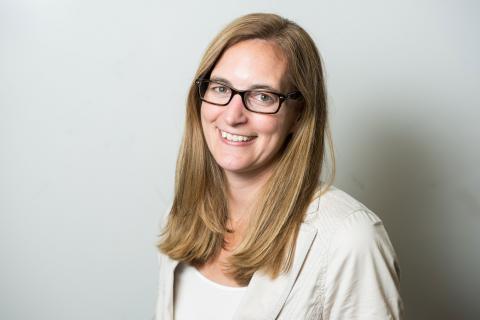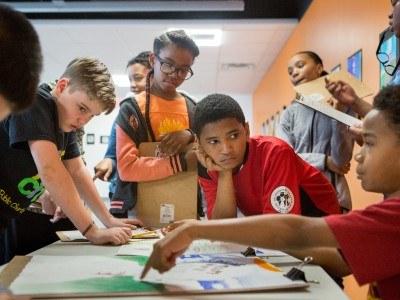Professional Learning
Creativity and Technology at the EDUCAUSE Annual Conference
Topics

Educators are the lead learners in schools. If they are to enable powerful, authentic, deep learning among their students, they need to live that kind of learning and professional culture themselves. When everyone is part of that experiential through-line, that’s when next generation learning thrives.
A look at the keynote talks from Sir Ken Robinson, Jane McGonigal, and Paul LeBlanc at the EDUCAUSE Annual Conference.
Returning from sunny and festive Anaheim, this year’s location for the EDUCAUSE Annual Conference, we can step back and look at the week’s events with a broad perspective about all that happened, all that we saw, and all that we heard. The program was punctuated with keynote talks by Sir Ken Robinson, Jane McGonigal, and Paul LeBlanc. It was sprinkled with concurrent sessions focused on NGLC Breakthrough Models for College Completion. It was a time to network with 7,000 of our closest friends and colleagues. (Well, I don’t think I met everyone, but I did thumb wrestle with a few thousand of them!) And it was a time for participants in the first-ever Breakthrough Models Academy to present their team projects and compete for top honors. (Nancy Millichap will share more on the Breakthrough Models Academy competition in a future post.)
Sir Ken Robinson kicked off the conference by focusing on the cultural elements of innovation. Engaging the audience with his storytelling and dry British humor, Robinson defined the role of technology in our culture, inside and outside of education. Technology, even from the very early days of human history, he said, has two functions: 1) to extend our reach (literally and figuratively), and 2) to do something new, that was never before imagined. Higher education can harness technology for both of these functions, but only if we are careful about how we encourage or discourage (intentionally or unintentionally) creativity in learning, as demonstrated in this video clip he showed.
Jane McGonigal carried the conversation around creativity (or lack thereof) in education by challenging us to learn from massive multiplayer games where players are engaged (so say their brain scans), resilient (they fail more often than they succeed yet they persist at the challenge), and work together to tackle complex problems. To illustrate, McGonigal pointed to gamers solving an HIV protein folding puzzle in 10 days that researchers spent 10 years trying unsuccessfully to solve; and EVOKE, a social network game focused on creative solutions to urgent social problems, as compellingly described in this trailer.
I was admittedly surprised by the top 10 positive emotions associated with playing video games that McGonigal shared, but most intrigued by what was #1 on the list: creativity. Gamers truly enjoy figuring out and doing something that they have never done before. Can we recreate that or harness it in higher education?
And Paul LeBlanc, president of Southern New Hampshire University (an NGLC grantee for its College for America breakthrough degree program) closed out the conference with his take on creativity, the kind that helps us think about how to fix what’s broken in higher education. We should know which higher education we want to fix, how we will utilize technology to do it, and how we might unbundle the functions of teaching and learning. You can watch his session online.
In between these big talks, NGLC grantees had their turn to share how they are using creativity and technology to recreate higher education, in an effort to promote completion in high-quality, affordable degree programs for underserved, low-income students. In the recorded session, Teaching and Learning Breakthroughs: Next Generation Academic Models in Practice, three grantees presented their academic innovations.
- Barbara Hunt of Columbus State University, an institution in the University System of Georgia, introduced their approach to a compact curriculum (that doesn’t cut corners). Learning support (that is, developmental) classes are incorporated into regular classes—students enroll in a credit-bearing math course and complete developmental math modules as needed within that course, in effect taking one class instead of three. “It has a really strong psychological effect on weaker students,” said Hunt.
- Peter McAliney shared some key aspects of the Ameritas Hispanic Pathways program that provides for the first 30 credits of college learning for Hispanic students that are English language learners. Ameritas was funded by NGLC to build a dual language content management system that improves content authoring, the learner and instructor experience, and analytics, all of which are expected to ultimately improve results.
- Karen Dowdall-Sandford described the academic model of the Early Childhood & Family Studies online degree completion program at the University of Washington, which involves a defined curriculum pathway that follows the Know, See, Do, Reflect, Improve pedagogical approach adopted by the University of Washington faculty. Students use video to get frequent feedback on their teaching practice in a Coaching Companion platform.
The academic breakthroughs exemplified by these presenters are complemented and supported by grantees’ breakthroughs in traditional business models in higher education. In Rethinking Business as Usual in NGLC Breakthrough Models, also recorded, Jennifer Freed of Rio Salado College, James Selbe of Kentucky Community & Technical College System, and Emily Chiu of New Charter University talked through their approaches to enrollment, financial aid, technology tools to support student success, faculty and instructional staffing models, and costs.
- Jennifer Freed talked about the unique faculty model that the fully online Rio Salado College employs and how faculty and the instructional technology support team work hand in hand to support students and help them master their learning.
- James Selbe focused on the impact that the the linear, modular, one course at a time academic models of KCTCS’s Direct2Degree program has on the business structures needed to charge tuition monthly, to enable disbursement of financial aid, and to budget for expenses, especially in a policy environment that is difficult for a competency-based program to navigate.
- Emily Chiu emphasized how New Charter University’s business model and academic model, specifically designed for their student population, work hand in hand. Students can enroll in 30 minutes or less (compared to 30 days at other institutions), they can register with the online site for free and explore the courses and content before they officially enroll (that is, “try before you buy”), and they can move at their own pace through tightly aligned competencies. Much of this is enabled by the low price for students and New Charter’s decision not to participate in the federal financial aid program.




